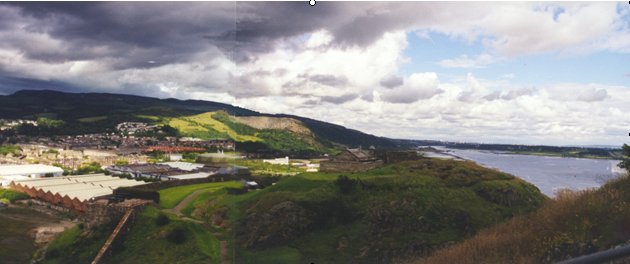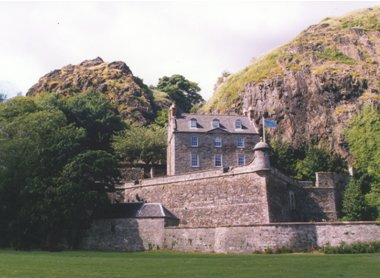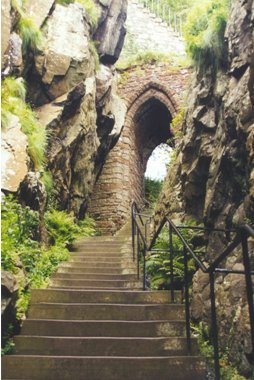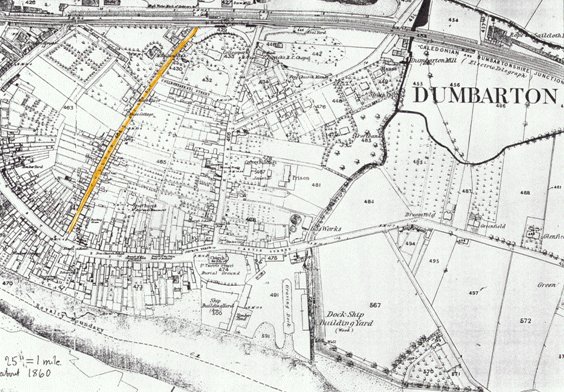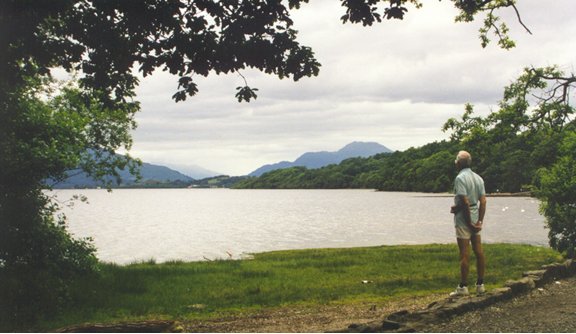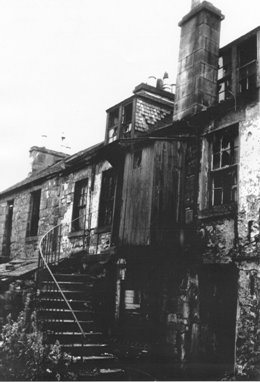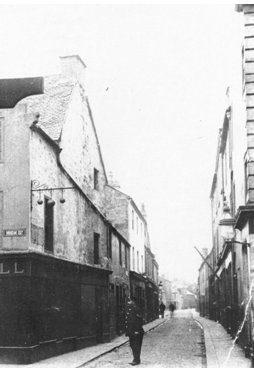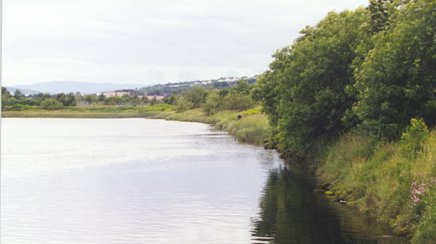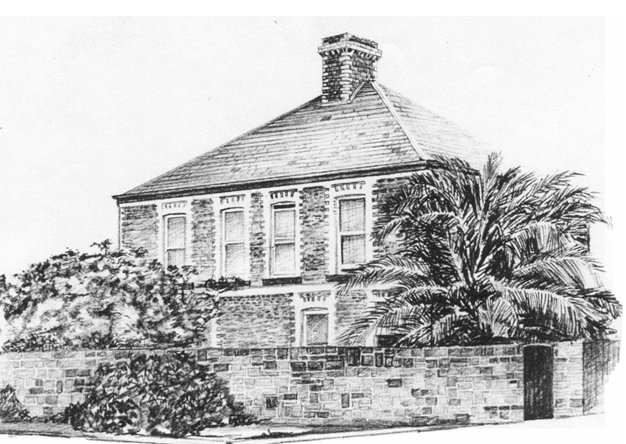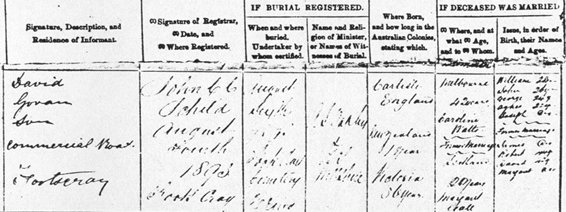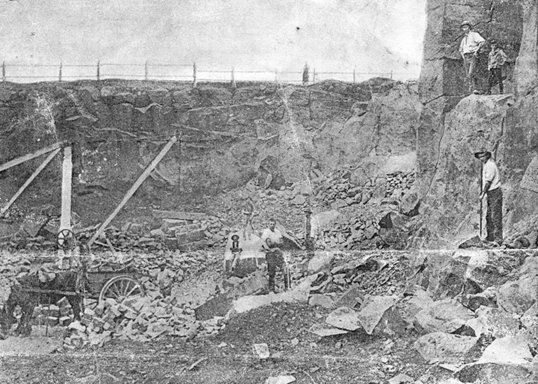The GOVAN Family HistoryClick here to view the GOVAN Family TreeJames and Eliza Ann Govan | ||||
|
The connection between the GOVAN family and the NEWMAN family was made when Davina Jane GOVAN married Sydney William NEWMAN.
Having the name of Govan means that the family most likely originated in Govan which was once a small village near Glasgow, Scotland. It is now a suburb of Glasgow. Our particular family probably left Govan in the 11th or 12th centuries and moved to another part of the country, although it would seem not very far. Surnames came into being at about that time and people were often called by the name of the place from which they came to identify them, e.g. at first it would have been "James of Govan" and later shortened to "James Govan". | ||||

Map of the part of Dunbartonshire and Renfrewshire where the Govan family lived, showing the villages, etc. mention in this history. All are well within 20 miles of Glasgow. | ||||
|
Early History of the Govan Story
The Old Parish Registers for Old or West Kilpatrick show that on 3rd February 1694 Robert Govane (1) and Agnes Allan proclaimed their intention of marrying by consigning two `Dollars' to the church authorities. This was a pledge that they would go through with the marriage within a customary time (and not fornicate before). A Dollar at that time in Scotland was the name given to the four merk piece - a silver coin issued during the reign of Charles II (1660-1685). It was worth £2.13.4d in Scottish money or 4 shillings and 6 pence in Sterling. Not only did they have to hand over the two dollars (a very large sum of money in those days) but also `one full' which apparently means a full measure, referring to a firlot or a bushel. A firlot was a Scottish measure of corn equal to a quarter of a boll; a boll varied according to the commodity and the locality, but a boll of meal (the most likely meaning here) weighed 140 pounds (about 63.5 kg) So it seems that Robert and Agnes had to hand over 35 pounds of meal plus 2 dollars to show that they seriously intended to marry. Apparently some of the money and perhaps all of the meal would have been returned when the marriage contract was fulfilled. (I am greatly indebted to Mr Norman Thompson, Auchterarder, Scotland for all this information and explanation and for a large amount of the research on the early members of the Govan family.) The Old Parish Registers for Old Kilpatrick show considerable damage but five children have been found there for Robert and Agnes. The eldest child was William who was baptised on 26th January 1696, then came Agnes, baptised on 27th March 1698, Robert(2), baptised 15th December 1700, (my five times great-grandfather) Jean, baptised on 7th March 1703 and lastly Patrick, baptised on 9th May 1709. Witnesses to the baptism of Robert(2) were Patrick Allan and James Govan. At the time Robert (1) and Agnes were married William of Orange and his wife Mary (daughter of King James II) were joint king and queen of Great Britain. Mary died in 1694 and William in 1702 when Mary's sister Ann became queen so our Robert(2) was born in the reign of King William (1689-1702). He was born 7 years before the Act of Union of 1707 which brought to an end Scotland's parliament (until restored again in 1999), and introduced a single parliament for the whole of Great Britain. Scotland retained a separate legal system as well as a different established church and education system. Scottish banks kept the right to issue their own bank notes. Robert Govan(2) married Agnes Paterson in Old Kilpatrick sometime in August 1727 having made a proclamation of marriage on 4th August 1727. They consigned the sum of Ten Shillings Sterling at their proclamation. Again this was a large amount of money as at that time the Sterling pound was worth 12 times more than the Scottish pound. Agnes Paterson was the daughter of James Paterson and Janet Donald who were married on the 2nd December 1697 (having paid one Dollar at their proclamation) in the parish of Renfrew. In Scottish records of births and baptisms, unlike English records, the mother's maiden name is always given which certainly helps when tracing a family. The family was Jean, baptised 30th January 1698 in Bonhill, Anna, born 9th & baptised the 10th of August 1700 at Cardross, James, born 20th and baptised 23rd May 1703, Agnes, born 22nd and baptised 23rd January 1707 (my five times great-grandmother) and Margaret, baptised 26th March 1710. Agnes seems to have been baptised the day after she was born: one wonders if this was done at home as the baby was sickly and perhaps might have died. The eldest of Robert(2) and Agnes' children was Robert, baptised 8th September 1728, then Agnes, baptised 21st February 1731 and lastly James (1), baptised 4th November 1733 (my four times great-grandfather). At this time England and Scotland were using different calendars. England was still using 25th March as the beginning of the legal year (not changing to 1st January until 1752): Scotland had been using the 1st January as the beginning of the year since 1600 therefore all the dates given before 25th March would have been given a date a year earlier in England. The words in the registers of the baptisms of Agnes are ".baptised Agnes Govan Daughter to Robert Govan in Mains ." . There are similar words for the baptism of Robert. In Scotland the word "Mains" means the home farm of an estate, cultivated either by the proprietor himself or on his behalf, although it is often used just to refer to a farm. From this evidence it would seem that Robert(2) was a farmer. Agricultural conditions in Scotland at this time
"It must afford great pleasure to the traveller to observe the neat farm houses, which are interspersed through this country. .. Instead of the old low-built and confined houses, which their fathers inhabited [they have] houses and offices suited to their respective farms, upon a plan, which conveys an idea of neatness and improvement that is highly pleasing." The farms were producing corn, bear (a type of barley used for the making of beer), barley, wheat, peas and potatoes. In the early years every farmer also kept a few sheep but this practice died out. Better roads also made the carriage of goods (in carts) much easier. The population of Old Kilpatrick in 1755 was 1281 souls. By 1792 it had risen to 2452. According to this account, many of these people were employed in printfields, paper manufactory, a smith and iron manufactory and one woollen manufactory (the first in Scotland). Portrait of the Scottish People
"The people of this parish may be said to answer the general character of the Scotch, for they are sober, honest, and industrious. The demand for workmen and artificers is so great, that there is not an idle person to be seen. At the wool mill and printfields, great numbers of young persons are constantly employed, many of them below 8 years of age, who earn from 4d to 8d, a day. And, as there are schoolmasters in the vicinity of all these works, the youth, when not engaged at their employments, go to school. In this way their business and education are united, while their morals are not endangered by idleness. All the young people of the parish dress well. The men wear hats and coats of English cloth. The young women put on silk and calico gowns, and black caps and cloaks. They meet together occasionally, and make merry. Their chief amusement is dancing, and upon these occasions there is a pleasing cheerfulness and innocence among them." Life must have been pretty hard for the children and that the minister should show such enthusiasm for the fact that their lives were totally comprised of work and study,, without any time for play, seems amazing to us today. This gentleman also tells us that "Inoculation is now generally practised in the parish, which is a happy circumstance, both on account of the population, and the difference it occasions in the look of the people." Inoculation against small pox was much resisted in many parts of the country (such as the Isle of Wight) so Old Kilpatrick was ahead of its time. He goes on, after an account of how in the past "As late as the end of the last century, a woman was burnt for witchcraft" to express "the fond hope, that the period is fast approaching, when all kinds of superstition and bigotry, will forever be banished, from the face of the earth." A nice thought! More Govan History
They had four children. The eldest was Robert(3) baptised Dumbarton 8th February 1758 (my three times great-grandfather), then Margaret, baptised 14th March 1760, Agnes, baptised 21st February 1762 and (another) Margaret, born on the 28th February 1765 and (according to the Old Parish Records) baptised on 31st February! For Margaret's baptism the address of the family is given as `Mains of Colquhoun'. So, once again the word "Mains" has been used in the records of these baptisms but this time the words "Mains of Colquohoun". Colquohoun (pronounced Co - hoon - with a guttural last syllable) is the clan name from the territorial area of Colquhoun on the west bank of Loch Lomond. The Earl of Lennox is recorded as granting a charter of the lands of Colquohoun to Humphrey de Kilpatrick in the 13th Century who later took the name of Colquohoun. Several of the clan chiefs were appointed as governors and keepers of Dumbarton Castle. In the 1630s Sir John Colquhoun was accused of absconding with his wife's sister, allegedly having used witchcraft and sorcery to carry this out! Very wisely, he did not come back to answer the charges and the lands were lost for a time to the family. They were recovered in 1646 by his son. The Colquhoun family were big land owners in the area and James must have been the tenant farmer on the Main or Home Farm. The land that James farmed was north-east of Dumbarton Castle. Its position has been identified from an old map held in the Local History section of the Dumbarton Library. The area of the farm has now been largely built on and is heavily industrialised. The Colquhoun family are still important landowners who live in the area. | ||||
|
| ||||
|
In the Old Parish Registers of Renfrewshire there is the report that Robert Govan(3) and Agnes Ritchie booked their names for proclamation in order to marry on 17th May 1783 in the parish of Inchinnan, Dunbartonshire. Renfrewshire lies to the south of the river Clyde, on the opposite bank to Dunbartonshire. Inchinnan is a small parish in Renfrewshire, bounded on the north-east by the Clyde (which divides it from New Kilpatrick in Dunbartonshire). The derivation of the name `Inchinnan' is interesting as it shows that the Clyde had once been a much shallower, more widespread river. `Inch' means island and `innan' the name of a patron saint. So Inchinnan was once an island. Robert(3) was a `Land Labourer at Garnel', which, I expect, is the same as an agricultural labourer in England. The children of Robert Govan(3) and Agnes Ritchie were:- Robert, born 29th December 1783, baptised 18th January 1784, James(2), born 9th April 1786 (my great-great-grandfather), baptised 16th April 1786, Margaret, born 31st December 1787, baptised 6th January 1788, Agnes, born 7th September 1789, baptised 13th September 1789, Mary, born and baptised 8th May 1791 and Janet, born 1st October 1792, baptised 7th October 1792. Dumbarton Castle
| ||||
|
||||
|
Very little survives of any ancient buildings but there are some seventeenth and eighteenth century fortifications to be seen. The last of the governors of the castle died in 1843. It was visited by Dr. Samuel Johnson in 1773 and many other important people. Queen Victoria visited it in 1865. It is now open to the general public. Although I don't know if any of our Govans would have been able to visit it, they certainly would have seen it as it is an important part of the landscape. I visited it when I was in Dumbarton. Most of the buildings, such as the Governor's residence, snuggle between the two volcanic plugs and by climbing steep steps I was able to get to the top of both plugs where there is a magnificent view of the Clyde and surrounding country. Back to the Govans
Agnes Govan, the wife of Robert(3) died and was buried in April 1795. In May of the same year Robert(3)'s mother (Jean Brock) also died. Agnes was only 41. For Robert(3) to have lost his wife and mother so close together must have been very difficult. A sum of 4 shillings was paid for each of the burials. This was probably payment for use of one of the parish mortcloths. A mortcloth was draped over the body, or later the coffin, before burial. They were hired out at the time of a burial, the better quality cloth costing the bereaved family more, and the money was used, along with other Kirk income from marriages and fines, to assist the poor in the years before 1845 when the Poor Law Amendment (Scotland) Act came into effect. When Robert(3) died in September 1814, in Erskine, Renfrewshire, 2 shillings and sixpence was paid for his mortcloth! Robert Govan(3) seems to have been the last of the Govans to have worked on the land. The earlier families of Govans, Patersons, and Ritchies had all been tenant farmers. Robert(3) was an agricultural labourer and from then on in Scotland we have the jobs of slaters, plasterers and bricklayers. I am sure that James Govan(2), son of Robert Govan(3) and Agnes Ritchie is my ancestor; firstly as the date of his birth ties up nicely with the age of 55 attributed for him on the 1841 Census; and secondly because of the system of naming children in Scotland which I have mentioned before. Two generations down from this, in the family of James Govan(3) and his wife, Margaret Gall, we find the first male child is called James (after his father's father), the second child is called Robert (after his mother's father), the third male is not named after his father as that would make a second James and is called David. The first female child is called Margaret Fletcher (after his mother's mother). I guess that the maiden name of Fletcher was added to make everyone totally aware that the child was named after the mother's mother as there was a Margaret in James' family too. I think I rest my case. James(2) did not stay put in Old Kilpatrick for the next sighting of him is when he was married to Agnes Winscal (Ann according to her marriage record) in Castle Carrock, Cumbria on the 31st October 1807. They were both described as `being of the parish', James(2) signed his name and Ann placed her mark (a cross). It was because James(2) was described as "being of the parish" that I originally began looking for his parents in that area and I actually found a James Govan who almost fitted at Kirby Stephen, Westmoreland. I also followed back the parents of Agnes Winscal. The name Winscal then would have been written by the man who wrote up the marriage in the register in any way he liked. i.e.Winskill/Winskell/Winscale. The year of the marriage of James(2) and Ann/Agnes was also the year in which William Wilberforce was able to achieve the abolition of the slave trade. I wonder if they were aware of this. The parents of Ann/Agnes are given as John Winskell and Mary, nee Hamilton. Ann/Agnes Winscal (my great-great-grandmother) was baptised on 25th March 1781 in Dufton, Westmorland. John Winskel and Mary Hamilton were married at Warcop, Westmorland on 4th March 1776. There is a small village in Westmorland called Winskill. That would be where the family originated. I am always surprised just how much these families moved from place to place. John Winskel was a blacksmith, according to the notice of death of his daughter, Ann/Agnes and perhaps it was through this trade that he was forced to move around. The son of James Govan(2) and Ann/Agnes Winscal was another James Govan(3) who was born in England c1821. His Australian death certificate tells us that he was born in Carlisle. Later I found that he had a sister, Janet Crumlich, nee Govan, who according to the Scottish death indexes was also born in Carlisle (1815). I have not found births or baptisms for either of them, nor have I found any other siblings. There is a gap of 6 years between the births of James(3) and Janet so I suspect there are some missing siblings somewhere. At some time the family must have moved back to Dumbarton, Scotland, for the next sighting of them is in the 1841 Census. There the information is very sparse. All we learn is that James and Agnes Govan lived in College Street, Dumbarton. James is 55, born in Scotland and a bricklayer and Agnes is 60 and born in England. This all ties up nicely. Unfortunately by then their children had all left the nest; James(3) marrying in 1840 and his sister Janet, marrying James Crumlich in 1839. Dumbarton
| ||||
|
| ||||
|
More Govans
The 1841 census also tells us that James Govan(3) and his wife Margaret, both aged 20, were also living in College Street at that time. They may even have been living separately in the same house as James and Agnes, for I understand that the houses had multi-occupancy. College Street derived its name from a College founded in the 14th century by Isabella, Countess of Lennox. It stood where the railway station is now, but has long gone. the River Leven and Lock Lomond
| ||||
|
| ||||
|
The Govans again
Margaret Gall, my great-grandmother, was the eldest daughter of Robert Gall and Margaret Fletcher who had given their names for proclamation to marry on 23rd October 1819 in Cardross, Scotland. According to the Marriage and Birth records in the Old Parish Records for Cardross her siblings were:- Robert, born at Mains 24th March and baptised 12th April 1822 (the Old Kilpatrick records give his birth date as 7th March and his baptism as 7th April 1822), Katherine, born at Mains on the 7th April and baptised on 25th April 1824, Ann, born at Mains, 16th December 1826 and baptised on 8th January 1827, John, born at Clarkhill on 10th March and baptised on the 8th April 1832. In 1842 Margaret Gall's father, mother, brothers and sisters had emigrated to Australia on the `Robert Benn'. The Australian (Victorian) death certificate for Robert Gall Snr. in 1868 lists his children as Robert (46), Catherine (42), Peter (39), Jane (37) and John (35). So there is some discrepancy here with the OPRs; there is no Ann in the Australian death certificate so I presume that she died and Peter and Jane are not mentioned in the OPRs. | ||||
|
Listed are:- Agnes Govan, Head [of household], Widow, 70, Housekeeper, England [born] James Govan, son, married, 30, Plasterer, ditto Margaret ditto, Daughter-in-Law, married, 30, Dumbarton, Dunbartonshire James ditto, grandchild, 5, ditto Robert ditto, ditto, 2 David ditto, ditto, 6 months. James Crumlich, lodger, 7, Renfrew, Greenock.(This must surely have been Janet Crumlich's son and therefore a grandson of Agnes) | ||||
|
Embarkation for Australia
Meanwhile back in Dumbarton
| ||||
| ||||
|
Tragic Drowning
| ||||
|
| ||||
|
In June 1999 when I visited Dumbarton, I walked along College Street and under the railway arch to `the meadow' as Agnes would have done that cold January morning (`the meadow' is now an industrial estate). I then walked along the River Leven. It was a very moving experience to see where the body of Agnes Govan was found and later identified by her daughter, Janet. The Leven is a very fast flowing river so if someone fell in they would have very little chance of recovery especially if hampered by the heavy, cumbersome clothing a woman at that time would have been wearing. In another part of the paper there was an account of a severe frost that day so probably the banks of the river were very slippery with ice and the water of the river very cold Perhaps Agnes leant over just a bit too far to pick up a piece of wood for her fire and slipped. I have not found a coroner's report. | ||||
|
| ||||
|
| ||||
|
The Voyage to Australia and death of Margaret Govan
This information was given to me by Lisa Telburn who I had been put in touch with through the Internet. She is my first cousin twice removed - a descendant of my mother's sister Evelyn, or, as we knew her Auntie Evie. In 2001, in order to verify his existence which had been given to me without any verification, I applied to the Victorian Register Office to get his death certificate. I knew from previous experience that a Victorian certificate would give me details of his birth as well as his death. I was delighted to find that yes, his birth on board the "Brilliant" in 1855 on the voyage out from England was there but not only that for the certificate told me that he had died on 8th January 1862 by drowning. This was the third member of this family who had met their death in this way - the boy's great-grandmother, Agnes Govan, who was drowned in the River Leven, Dumbarton, Scotland and his brother, my grandfather, James Govan who fell in a flooded, disused quarry some time later than the death of William. Lisa Telburn was able to send me a copy of the coroner's report from which I learned that William (aged 7) was not living with his widowed father but with a widow, Mrs McLagan, helping her with her cows. He had been sent out to `turn' the cows and didn't arrived back home. Mrs McLagan went looking for him and found him, face down and drowned in a waterhole 10 yards from the house. It was assumed that he had tried to get a drink from the waterhole and slipped. He could not swim. Mrs McLagan wrapped him in a blanket and walked a mile to inform his brother (she does not say which brother but it could have been James) who informed his master who informed the police. Second marriage of James Govan(3) and the Bluestone Quarry
James Govan(3) had been named as a plasterer and slater on his son's birth registration in Scotland. He carried his skills in stonework with him when he emigrated to Australia and was a pioneer of the bluestone industry in Australia. He first quarried stone in Stony Creek, Victoria and then in Footscray where he had his own bluestone quarry. The quarry has now been filled in and a sports field occupies the space where it was. When James(3) had the much wished for opportunity of buying the quarry, it came with a house which was at that stage unfinished. He finished it with his bluestone and moved in with his family. James(3), Caroline and their nine children lived in a house which has come to be known as Govan's Place, 98 Summerhill Road, Footscray, a suburb of Melbourne. The house continued to be lived in by descendants of James and Caroline until comparatively recently. | ||||
|
| ||||
|
The house has been described in an article in The Age, a Melbourne newspaper, as having "serenity and charm of the past century, with superb fireplaces and a well cared for shady old-world garden". The National Trust has classified the house as D i.e. `notable, preservation desirable' It is brick fronted with a bluestone back. At that time brick was more "classy" than stone. It is very like houses in Dumbarton which he would have been familiar with and totally unlike the single storey wooden houses which surround it. The house has now been turned into two town houses. At the time James and Caroline were living in it the house had four bedrooms on the first floor and four rooms on the ground floor. A kitchen and bathroom were added to the back of the house at some time. I have corresponded with a Mrs Marjorie Paxman, who was the daughter of William Govan, the eldest son of James(3) and Caroline Govan. She lived in the house for many years with her parents, her unmarried sister and her husband and children and so was able to tell me what it was like when she lived in it. There seems to have been two steep staircases up to the first floor for she says that "the space under both staircases made good storing cupboards with doors". It would have been a very simple alteration to turn this house into two houses. | ||||
|
| ||||
|
The importance of the Bluestone to Melbourne The stone from the quarries of James(3) built many of the major buildings in Melbourne that are still standing today. Amongst them are St Patrick's cathedral, The Exhibition Buildings and The Town Hall. James(3)'s son, David, carried on the business after his father rather than his first son James (4), my grandfather, who had died before his father. Under David's management the bluestone from this quarry was used to build more notable buildings: The Eastern Market, The State Houses of Parliament, the Law Courts and the Government Printing Office amongst others. James Govan(3) died on 4th August 1893 of "chronic hepatitis and acute syncope". On his death certificate it says that he went to New Zealand for a year but I know nothing of that. From fairly humble beginnings in Scotland, James Govan(3) became a much respected and important member of society in Footscray, Melbourne. There are streets named after him in the area. He contributed a great deal to the young, developing city of Melbourne. | ||||
|
| ||||
|
The eldest son of James(3), my grandfather, James Govan(4) predeceased his father by his tragic death in 1886. |

